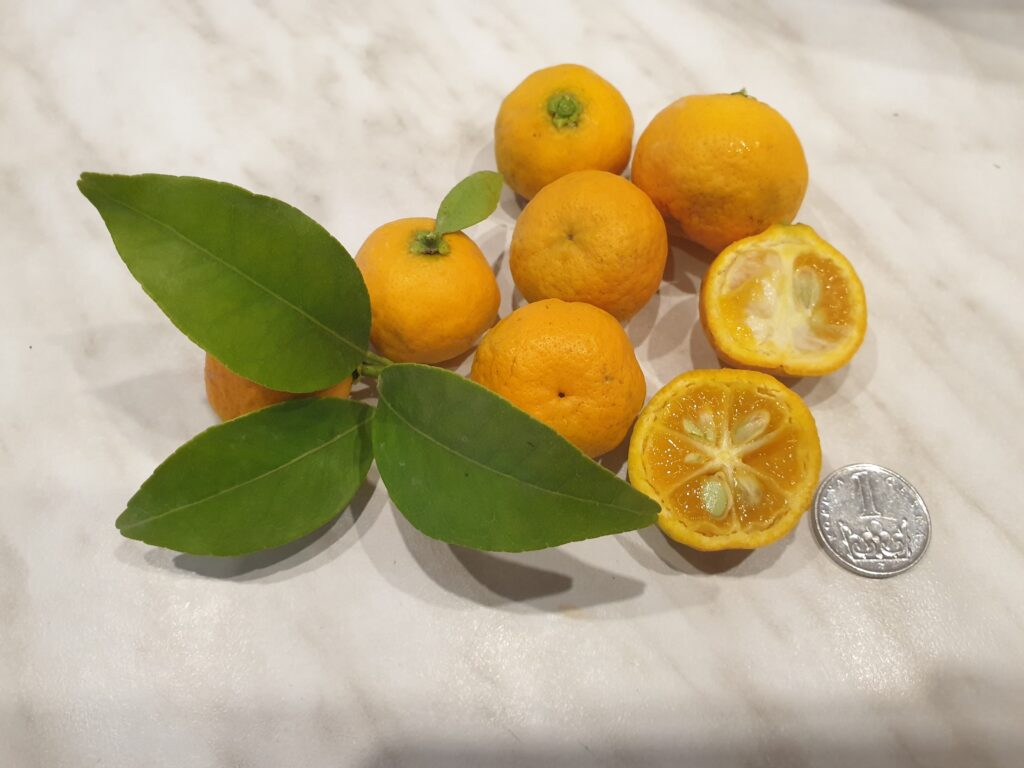Tachibana, Citrus tachibana (Makino) Yu Tanaka, is a culturally important ornamental citrus grown throughout Japan. In Okinawa, it was wild in low-lying forests (Tanaka, 1957). Like Shiikwaasa Tachibana is named in traditional Ryukyu poetry and songs. Wu, Sugimoto et al. (2021) suggest that it is a native botanical hybrid.
Most early mentions of Tachibana praise its sour, heady scent. During the Heian period (794-1185), women of the Japanese aristocracy perfumed themselves with Tachibana, tucking sachets of its flowers into the sleeves of their kimono or stringing the fruits on strings and wearing them as bracelets. The Man’yōshū, the oldest surviving collection of Japanese poetry, contains 70 poems about or referencing Tachibana and celebrating its enchanting fragrance. In the Edo period, Tachibana became more accessible to classes outside the aristocracy, with many families using the fruit in domestic offerings to the gods. But despite its increased popularity, Tachibana still maintained a strong position in royal circles: at the same time, there are references to ripe Tachibana fruit being presented to the imperial court and the shogunate. Despite its value, Tachibana was not something that people commonly ate. It was primarily a symbolic fruit.
By order of the Ministry of Education in September 1945, teachers and students throughout Japan were required to erase nationalist content from wartime textbooks with ink and scissors. Because of its association with the imperial family (which had long cultivated the Tachibana as a symbol of longevity), references to the Tachibana were probably also erased. According to this theory, this had the effect of erasing, or at least greatly diminishing, the presence of Tachibana in the Japanese collective consciousness. It is also true that Tachibana fruits are sour, perishable, and have no commercial value (Leow, 2022). Although they originally grew throughout the southern half of Japan (Tanaka, 1957), the plants are now so scarce in Japan that the Japanese ministry of the environment in 2012 listed Tachibana as an endangered species. In Europe, it is an interesting ornamental species due to its hardiness to -12°C (Bouladou, 2015).
According to legend, the emperor Suinin (29 BC – 70 AD), with one foot in the grave, ordered a man to go to the underworld and bring back the fruit of immortality. Although he returned too late to save the emperor, the fruit and branches he brought were reportedly planted in the temple of Tachibana. Although the story may be apocryphal, the temple still stands south of the city of Nara and several Tachibana trees are found on its grounds (Leow, 2022). But what is the origin of Tachibana according to scholars?
Genome analysis showed that the small-fruited Tachibana mandarins are a natural botanical cross between the native Citrus ryukyuensis Wu and an unknown species of Chinese mandarin, a hybrid between Manshanya and the wild Chinese mandarin (Citrus reticulata Blanco). Manshanyeju is another native species of wild mandarin from the Nan-ling Mountains in southern China. Simply put, Tachibana is a hybrid of three wild mandarins without crossing with pomelo.
Importantly, the mainland parents of Shiikwaasa and Tachibana are not related, which means that these Okinawan hybrid species originated independently. Unlike the simple hybrid origin of Citrus depressa Hayata the genotypes of Citrus tachibana (Makino) Yu Tanaka are more complex. Multiple crosses have occurred in Tachibana, and the high genomic variability suggests that all Tachibana are not completely siblings (Wu, 2021). Shimizu (2016) reports three genetically distinct strains of Tachibana in Japan.
Tachibana and Shiikwaasa are similar in appearance, but Tachibana fruits are usually more spherical 3.5 × 2-2.5 cm, although there is some variation.
TTachibana grows as a shrub or tree from 3-10 m. The leaves also have some variation, but are rather oblong, unlike the ovate leaves of Shiikwaasa, the margins entire to serrated, the apices pointed. Flower white, 1.2-1.4 cm in diameter; fruit yellow, globose, 3.5 × 2-2.5 cm.

